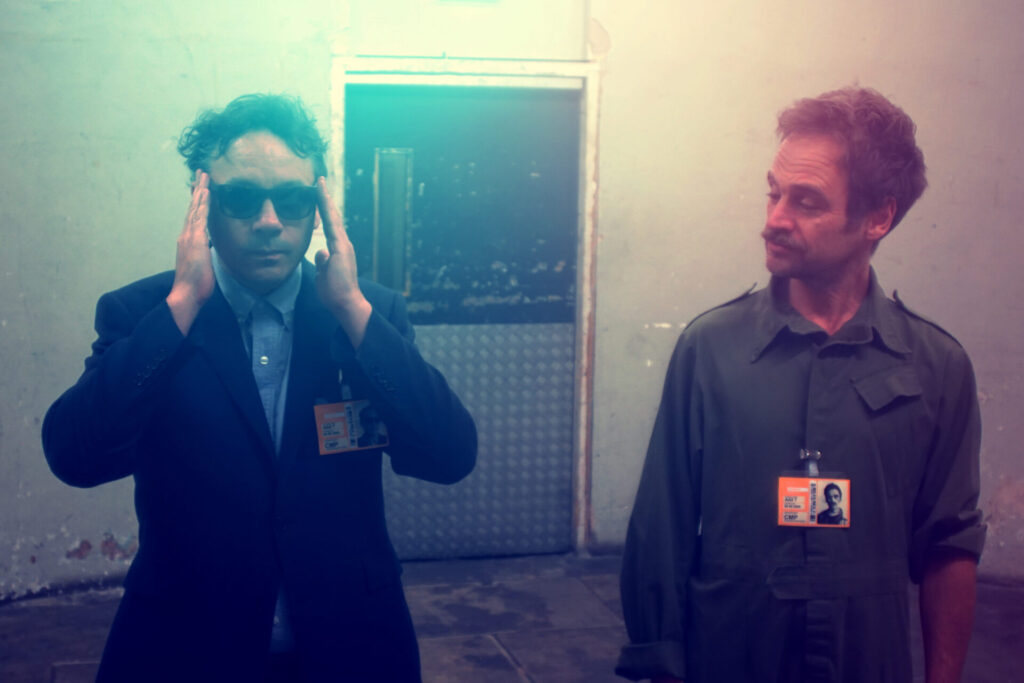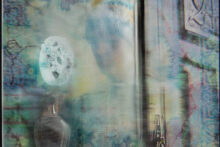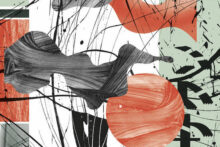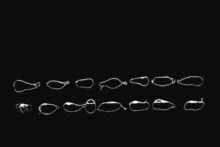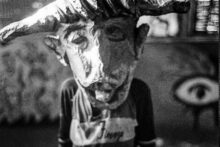“In an age in which all media are at least potentially up for grabs, the challenge for artists lies in choosing which music is best suited for each format,” writes tQ reviews editor Robert Barry in his book Compact Disc (part of Bloomsbury’s Object Lessons series) less than four years ago. Considering today’s (obnoxious, problematic) pervasiveness of streaming services, this thought sounds increasingly quixotic. If anything, the opposite of Barry’s idea has manifested. With streaming now the de facto standard for music distribution, physical media like vinyl have become their own purpose, chosen and considered not so much for being appropriate to hold the music pressed on them, but to be fetishised and made into frivolous curio.
For the past fifteen years, musician Dan Hayhurst and visual artist Reuben Sutherland’s “opto-musical agglomerate” project Sculpture have straddled the line between these two extremes, subverting, rethinking, and incorporating the material properties of the chosen medium into their work, be it vinyl records, cassettes (Sculpture) or comic books (Nearest Neighbour).
Akin to Tristan Perich’s 1-bit microchip compositions embedded in CD jewel cases, vinyl discs become a multimedia projection canvas for Sculpture, carrying not only Hayhurst’s loopy electronics but also Sutherland’s hypnotic visual constructs for synaesthetic effect. Similar to 2010’s Rotary Signal Emitter and 2011’s Toad Blinker (both on Dekorder), their new album Max Ax comes printed on two double-sided zoetropelike vinyl picture discs, whose sophisticatedly painted rings shapeshift into cyclical animations as the records spin at 45 RPM when illuminated under the right light.
Somewhat ironically, the album’s physical artefacts are unavailable to me as I type this review. Instead, I’m watching YouTube promo recordings of the kaleidoscopic, psychedelic, and dizzying animations that rise up from the spinning discs – their colourful emanations occasionally reminiscent of the proto computer art that William Latham made for The Shamen in the 1990s. While the feeling is close to reviewing a soundtrack having only seen the film trailer, Hayhurst and Sutherland’s aesthetic and conceptual tendencies are interwoven on a deeper level, capable of functioning in isolation. “We met fairly randomly and realised we were both using very similar techniques and had a common aim: derangement of the senses to achieve a transcendental ‘thing’,” Hayhurst told The Wire in 2010.
Just as Sutherland’s art needs to spin to come into life, Hayhurst’s squelching, fractured, and disassembled electronic pieces exist in a state of constant circular motion. On the opening, eponymous track ‘Max Ax’, loops of bubbling, rhythmic sounds and Sun Araw-like “whoa” vocal effigies dance and twirl around each other. In the context of Hayhurst’s usual spastic productions, this cut is an exercise in linear storytelling, the melodies and unusually regular rhythms left to linger, evolve, and reach their natural conclusion.
But ‘Blood Sharpie’ is where the fun really starts. A frantic disarray of squiggling, sloshing effects flutters about the stereo field, like disoriented birds happily singing their songs while violently smashing into windows. The piece glitches, stumbles a few steps forward, then glitches again, spiralling through an assortment of scratches, modem bleeps, Plunderphonics, and percussive found sound. Like an off-centre record, it wobbles and shakes, never hitting quite the same patch twice. As in his solo work (Critter Party, Counters), Hayhurst is not interested in building songs or melodies. Instead, he stumbles into them almost by chance, entertains them for a fleeting second, then throws them away.
This particularly maximalist, voracious aspect of his analogue-digital compositional approach is crucial in ensuring that Sculpture’s work never feels dated or, god forbid, nostalgic. Despite Sculpture’s love for vinyl, analogue synths, and other stylistically marked vintage music-making techniques, their earlier records like 2013’s Slime Code and 2014’s Membrane Pop still sound as fresh as on the day they were released. In fact, the album cover’s prismatic, polyhedral construct that resembles a retro-futuristic robot head made out of parts of a modular synthesiser is as apt a representation of Hayhurst’s music and a tribute to Sutherland’s visuals as any.
Ornate staccato organ figures shimmer on ‘REPO’, as if sampled from a The Who song intro, and begin bumping along a thwacking, organic-sounding drum beat. The music is unstable and loose, stitched together with rusty wire, with layers of compressed synth rays and claps stomping on each other’s toes. Elsewhere, ‘Your Security Code’ and ‘Vent’ push nondescript boiling and clattering noises down a stairwell and into growling, spasmodic cascades, and ‘Cross Processor’ jumps into bass territories infected with striated lines – familiar enough to entice you to dance, strange enough to make it impossible.
Considering the idiosyncratic essence and crumbling architectures of Sculpture’s music, it might be tempting to invoke the likes of Ekoplekz, Proc Fiskal, and Container as their peers. Still, the significance of loops in this music moves them closer to Valerio Tricoli’s tape experiments or Carl Stone’s ever-revolving sample collages – albeit infused with a more manic energy. The latter’s influence is particularly present on ‘I Entered Into A Phase’, whose gorgeous mid-tempo rotation is filled with expanding harmonies and textures, plus the occasional digital beep and warble that sound like E.T. attempting to phone home.
The closing four songs manage to encompass Sculpture’s whole gamut of expressions. ‘California’ starts things off with pulsating, bucolic licks and lush melodies, only for the record to fall on the floor on ‘Chromophoria’. The track shatters into a million pieces. An anomalous jungle break and vaguely threatening subtext emerge from the chaos. Meanwhile, the relentless effervescence of ‘Wave Scroll’ transports you to the vicinity of an aquarium’s air pump and ‘End Of Inquiry’ conjures splashing electronics and elastic rhythms in the vein of Bruno Silva’s Serpente project, then stretches them out beyond the point of no return, into nightmarish cartoon pandemonium.
While Sculpture successfully subvert “the visual language of product design and commercial exploitation”, the ecological and social implications of physical media itself – themes convincingly explored in installations such as Darsha Hewitt’s High Fidelity Wasteland II: The Protoplastic Groove – are left untouched. Regardless, Max Ax ultimately works, both as a highly conceptual art piece and ludicrously fun collection of music.

